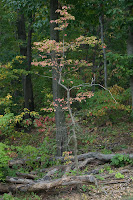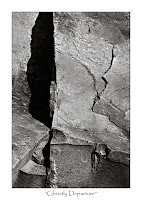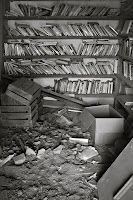
One of the special joys of photography is to discover something transcendent in what "objectively speaking" is completely
ordinary; and use the medium to share your vision with others. A case in point, is a simple, humble, little tree, that I always see just outside the first level of the garage I use to park my car for work, and as I make the first turn to find a spot to park. I see a bit less of it as I continue downward to the second level, and it disappears from view completely as I weave my way to the third, and final level. I almost always choose to walk up to the entrance of my building using the outside stairs, rather than take the elevator directly from the ground level, because I want to enjoy "seeing" this little tree for a few extra seconds before beginning my work day. It has thus been a quiet companion of mine for years; and always puts a smile on my face as I embark on my workday, readying myself mentally to be immersed in my usual sea of equations and computer code.
I call it a
humble tree, because that is how it appears to me. Its small and unassuming form is overshadowed by the thick trunks and dense foliage surrounding it. It is practically invisible, standing as it does just outside the garage, effectively lost among the scattered walkways, outside furniture and nearby construction. Sadly, it also does not appear to be doing particularly well physically this year, as its already lost most of its leaves, and very few achieved their usual rich autumn colors before falling. But there it stands, with its graceful arcs and branches serving as a subtle aesthetic ground to everything surrounding it. I silently lament how so few people ever seem to notice its delicate beauty. Though my coworkers frequently jog for exercise up and down the inclined hill on which it grows, few, if any, ever glance in its direction.
I resolved to show others what this serene sentinel has generously provided me for so long. I waited for a nice day (which, in photographer's speak, means an
overcast, moist day;-), started my commute to work a few minutes early to buy myself some extra time, set up my tripod on the first level and took a few exposures. Some friends passed by in their cars. Most smiled quizzically, and squinted from their seats to try to make out the source of my fascination. One, a fellow photographer, stopped by to take a closer look, and nodded appreciatively. Another, not a photographer, also stopped by and was visibly perplexed that this "unassuming tree" was really the subject of my focus. "I'll show you what I see later, when I've had a chance to express it," I said. "OK," he replied, "but its just a little tree, and not a terribly interesting one at that," and walked away.
What my
friend probably saw, was what my camera faithfully rendered with its CMOS circuitry, reproduced below...

What
I saw, and what I almost always see when I pass by my humble little friend, is the image that is reproduced at the top of this blog entry. The tree seems to be both
bathed in and to
emanate a soothing, ethereal glow; as though its roots are not just joined to the earth but stretch into something beyond as well. The mildly duotoned black and white conversion conveys something of what I see when I look at this tree; and it is not at all obvious from the "straight" color image.
I admit to it being a very pure joy for me, as a photographer, to not only be able to "see" this tree in its more resplendently luminous form - to see its very
soul, so to speak - but to be able to express (at least some semblance of) what I
feel while communing with it. The tree thus now rewards me
twice each day. Once, as it continues to paint a smile on my face when it greets me in the morning; and a second time, whenever someone comes into my office, notices the print I made of my
luminous companion hanging on my wall, and says (usually, with some incredulity!),
"That's not that little tree you were talking about, is it? Wow! Never thought much of it before. It's beautiful!"
As others have observed, one does not have to travel to exotic far-away places to find beauty.
 I am very pleased to announce that 24 of my photos (a mix of of landscapes, still lifes, and abstracts) will be on display 7 - 31 Dec, 2007 at Books & Books in Coral Gables, Florida. For those of you in the area with an interest in my work, please stop by for the opening of the exhibit on Friday, December 7, from 7 to 10 pm. Since Books & Books also has an in-house cafe, there will be ample - and free - (courtesy Dr. Rosa Abraira) munchies and drinks! :-) This wonderful local bookstore was founded by (current, and two-term, American Booksellers Association president) Mitchell Kaplan in 1982, and has since grown to become one of the best known and well-respected independent bookstores in the country. I am honored, and humbled, at having been given this rare opportunity to display a few of my works at this venue.
I am very pleased to announce that 24 of my photos (a mix of of landscapes, still lifes, and abstracts) will be on display 7 - 31 Dec, 2007 at Books & Books in Coral Gables, Florida. For those of you in the area with an interest in my work, please stop by for the opening of the exhibit on Friday, December 7, from 7 to 10 pm. Since Books & Books also has an in-house cafe, there will be ample - and free - (courtesy Dr. Rosa Abraira) munchies and drinks! :-) This wonderful local bookstore was founded by (current, and two-term, American Booksellers Association president) Mitchell Kaplan in 1982, and has since grown to become one of the best known and well-respected independent bookstores in the country. I am honored, and humbled, at having been given this rare opportunity to display a few of my works at this venue. and (2) Imposed Order, consisting of images of the natural environment upon which an implicit human presence has somehow knowingly, or unknowingly, imposed a nonrandom element.
and (2) Imposed Order, consisting of images of the natural environment upon which an implicit human presence has somehow knowingly, or unknowingly, imposed a nonrandom element. The pictures are all duotoned digital prints, using 100% cotton rag, acid-free fine-art paper and archival pigment-based ink (to maximize fade resistance).
The pictures are all duotoned digital prints, using 100% cotton rag, acid-free fine-art paper and archival pigment-based ink (to maximize fade resistance). So please come, have some free food and drink and (hopefully) enjoy some photos! (I plan on being there for the opening, and will likely stroll in a few times on the weekend as well;-)
So please come, have some free food and drink and (hopefully) enjoy some photos! (I plan on being there for the opening, and will likely stroll in a few times on the weekend as well;-)

















